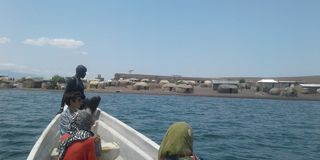A tour of the place where life originally started

Aproaching El Molo village from the sacred island. Photo | Rupi Mangat
What you need to know:
- It is here in Turkana that human-kind first emerged with the fossil of the Turkana Boy’s skeleton who lived 1.5 million years ago
- It is a land of paradoxes: intense heat and strong winds; a lake amidst a desert, a moisture-fed forest mountain amidst stark volcanic stretches
It’s a show-stopper. The first sight of Lake Turkana as we come over the ridge. All around us, it’s a stark landscape. Bare, black volcanic rocks and rubble, shallow gorges, intense heat, a bluer than blue sky and a blue-green lake shining under the midday sun, stretching endlessly into the horizon. It’s the Jade Sea, officially Lake Turkana, the world’s largest permanent lake in a desert.
A herd of camels appear over the horizon, a scene from biblical times. The camels make their way with effortless strides over the rocky lava landscape, after a drink at the lake. There’s no one in sight for miles around. Turning around, the view is of swivelling blades of the wind turbines – 365 tall structures to generate power. Placed in the strongest area of wind flow, the turbines are also in the same corridor of millions of migratory birds.
For the next 45 minutes the drive along the lake’s shore to Loiyangalani is mesmerising.
Every few miles, there’s a Turkana man, tall and skinny, walking with long strides under the merciless sun, carrying his wooden headrest that doubles as a stool. Doum rafts of the Turkana and El Molo fishers are brought out by the shore to dry under the sun. Some 25 kilometres later, huge settlements of Turkana doum-woven huts appear by the town and then we’re on the kilometre-long, one-street dusty town of Loiyangalani lined with dukas selling anything from mitumba dresses to the phone-charging kiosks with Mount Kulal looming over. The lake town was until the 1960s a watering point for the camels. It is a land of paradoxes: intense heat and strong winds; a lake amidst a desert, a moisture-fed forest mountain amidst stark volcanic stretches.

On the sacred island of El Molo onLake Turkana near Loiyangalani. Photo | Rupi Mangat
It is here that human-kind first emerged with the fossil of the Turkana Boy’s skeleton who lived 1.5 million years ago found at Nariokotome. Arriving late afternoon after an exciting drive through the mountain-filled, dry landscape from Ngurunit in the Ndoto Mountains, Benedict Orbora, founder of Palm Shade Camp and a local Rendille has the two-day stay planned for us.
Sail to El Molo Sacred Island
The 20-minute slow drive north of Loiyangalani is through a bare landscape to the El Molo village, one of the world’s smallest tribes. The village is similar to the doum-palm nuts of the Turkana. The modern invention is the primary school in the desert and a water tank. After a stroll around, we hop onto the fisher’s boat to a 15-minute sail to the volcanic island sacred to the El Molo.
A small group of El Molo fishermen sit under a shed, repairing their fishing nets after the night’s fishing for tilapia, catfish and Nile perch. There’s fish left to dry in the sun and exported to Kisumu on Lake Victoria. A few men fill the fish intestines with the fat from the fish. “It’s good to rub it on a child’s chest if it has a cold,” tells an El Molo man.
The island is bare but filled with volcanic ridges and plateau. Nobody lives on it. The sacred shrine of the ancestors is shaped in a hippo’s formation. My friends, tough and sturdy, vanish in the skyline to hike around it. Following them, from my high vantage point, my friends are swimming in the clear water…and swimming towards them is a crocodile. Thankfully still far.
Bellamy Lewan, the El Molo guide and l climb down the ridge to the waiting boat to sail to our swimming friends, passing the lone crocodile en route. It’s still far, so we join our friends for a swim in the world’s largest freshwater lake in a desert that is a UNESCO World Heritage Site.
Rock Art of the Ancestors
The following day, another 20-minute drive has us hiking up a mountain of sheer rock and stone with our Turkana guide, John Lokitir of Jade Sea Guides. In the midst of this rubble, sweating profusely, we’re looking at an enormous boulder at the Marti Rock Art site. It has giraffes and other animals sketched on it from 2,000 years ago. It’s hard to imagine that giraffes lived here. It’s harder to imagine anything surviving here now, except the camels. As l’m pondering that, Jan Coffey startles a striped hyena in its den. Both flee in opposite directions.
Stay at
Palm Shade Resort & Camp https://www.palmshaderesort.co.ke/ in Loiyangalani. It has ensuite rooms in the lush garden, a few traditional huts and a suite of modern rooms. It’s affordable luxury on full board. The staff is great and Benedict a good source of information.
After the rock art hiking, visit the Desert Museum that’s shaped like Mt. Por in the distance and enjoy a swim in the lake afterwards.
www.rupitheafricantrotter.com
For feedback to the editor email, [email protected]




